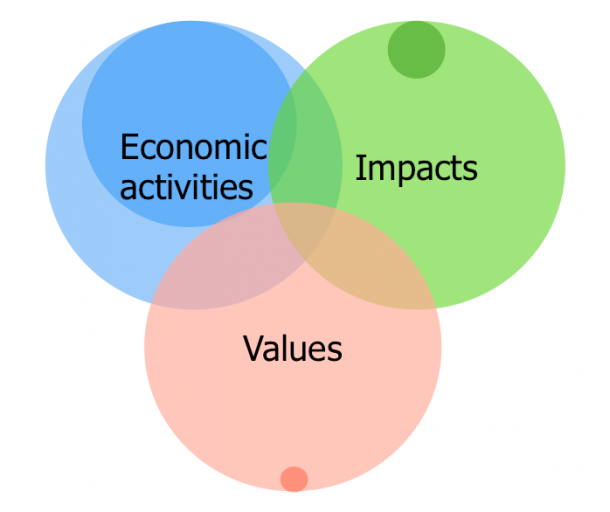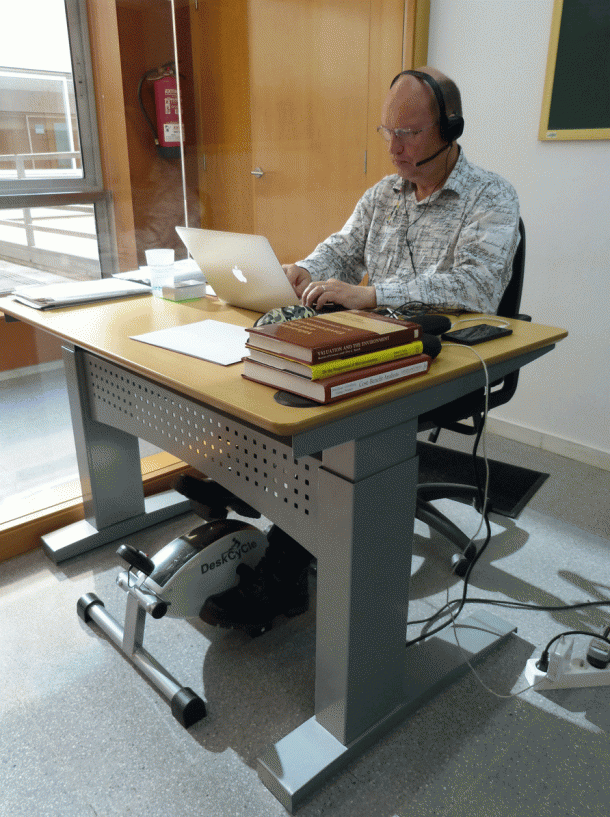Blog
The next step – open LCA data
May 26, 2017 by Bo Weidema
In a previous blog-post, I used this picture to illustrate the gap between the available information (the large circles) and how much of this information is typically used by current LCA practice (the smaller circles within each large one):

At 2.-0 LCA consultants we have been working hard to ensure that we use the most recent, transparent, reviewed, and spatially detailed data, modelling economic activities with data from globally complete and physically balanced IO-databases, including rebound effects based on marginal consumer behaviour, modelling impacts with a social footprinting method that covers the total global annual loss of natural habitats, human health, and social wellbeing, and by modelling values with data from welfare economics on market prices and representative population surveys, including equity-weighting and science-based discounting.
But staying on top of the current exponential growth of data requires the use of new social and digital technologies: To make efficient use of the options offered by what Klaus Schwab has called the fourth industrial revolution we need to cooperate as a community and use the automated tools of artificial intelligence to create and use linked open data. This is the reason that 2.-0 LCA consultants have decided to sponsor the work of BONSAI – The Big Open Network of Sustainability Assessment Information.
We see how other scientific communities, from astronomy to deep earth seismology, struggle with the same problems of managing the unprecedented amount of data needed to provide increasingly precise understanding and predictions within their fields. We see how these scientific communities have embraced open data as fundamental for the advancement of their research, and have started to cooperate across scientific disciplines.
Last month, I attended – together with BONSAI executive Michele De Rosa – the 9th plenary meeting of the Research Data Alliance (RDA). RDA is a community-driven organization with more than 5000 members from 123 countries, building the social and technical infrastructure to enable open sharing of big data. It was a vibrant, overwhelming experience that confirmed to us that the time for open science is now mature. With an interdisciplinary perspective, the many Interest Groups (IG) and Working Groups (WG) in RDA address common problems such as how to harmonize metadata structure, how to address data classification issues, how to credit scientists for sharing data, how to address the legal issues concerning the sharing and harvesting of data. If you are curious to know more, a full report from our activities at the RDA plenary is now available.
The scientific domains of LCA, industrial ecology and IO-economics, were, to our knowledge, represented at RDA for the first time by us, which made us feel more like representatives of a laggard community than pioneers.
We believe that the LCA community needs to come up to speed and engage more intimately with the data science community, and we therefore intend to maintain a constant presence in RDA. Plenaries are held twice a year and the next plenary will be in September in Montreal. We are working on a session proposal to create an Interest Group within RDA to target the needs of our scientific domain and invite the LCA community to join us with contributions and suggestions.
European pressure for a more sustainable palm oil production
April 24, 2017 by Jannick Schmidt
At their plenary session this month, the Members of Parliament voted on a resolution calling on the European Commission to work towards a European certification scheme for palm oil entering the EU market.
This political move comes at a most opportune moment for us here at 2.-0 LCA consultants; as we just this week are able to announce that our crowd-funded initiative: LCA of RSPO certified palm oil is up and running with currently 12 palm oil producing/using industries as members of the club. The initiative aims to compare the environmental profile of certified palm oil to non-certified palm oil in the market. Our project will be based on the already existing certification scheme by RSPO – but we hope to produce evidence, using life cycle thinking, that will also be relevant for a possible European certification scheme.
The Members of Parliament also call for a ‘phasing out of the use of vegetable oils that drive deforestation by 2020’. In our previous analysis of various biofuels, including several different vegetable oils, we found that a significant hotspot in the biodiesel product system is indeed indirect land use (deforestation) (Schmidt and Brandão 2013; Schmidt 2015). Regardless of which vegetable oils are used for biodiesel, our findings indicate that an increase in the use of biodiesel will lead to higher greenhouse gas (GHG) emissions, mainly because of the consequences of the indirect land use. On top of that, biodiesel from vegetable oils is associated with high impacts on biodiversity: deforestation caused via indirect land use changes.
In their press release the European Parliament also note that a major use for the European imports of palm oil is for biofuels. Kateřina Konečná, who edited the report on palm oil and deforestation of rainforests for the European parliament says that she hopes for a ‘total’ phase out of this use for palm oil. We have previously demonstrated that palm oil is the oil affected when there are changes in the demand for any unspecified vegetable oil (Schmidt and Weidema 2008). Therefore we believe that it is rather the entire market of vegetable oils for biofuels that needs to be discussed. Naturally, palm oil can be a suitable starting place for the discussion, and in this light we are hoping for a balanced response by European Commission.
In a market where everything is linked and palm oil is the additional supply for any demand for vegetable oil, a specific political ban on palm oil is not an efficient way forward. A better approach for the European Commission would be to reconsider the targets to increase the European use of biofuels in light of the evidence of its actual environmental consequences. Or at the very least to ensure that the sustainability criteria (See DG-Energy) for the European use of biofuels includes indirect land use effects. This is needed in order to actually reduce greenhouse gas (GHG) emissions – with consequences for the entire market of biofuels.
Instead of banning palm oil, we emphasize that a more efficient way to reduce the environmental impact is to collaborate with the palm oil industry. In fact, palm oil is the only major oil in the market, where there is a formalised way to make a difference with regard to deforestation, i.e. demanding oil from industries which ensure nature conservation within their concessions as well as in their surrounding communities.

References
Schmidt J (2015). Life cycle assessment of five vegetable oils. Journal of Cleaner Production 87:130‑138 https://lca-net.com/p/1719
Schmidt J, Brandão M (2013). LCA screening of biofuels – iLUC, biomass manipulation and soil carbon. This report is an appendix to a report published by the Danish green think tank CONCITO on the climate effects from biofuels: Klimapåvirkningen fra biomasse og andre energikilder, Hovedrapport (in Danish only). CONCITO, Copenhagen. https://lca-net.com/p/227
Schmidt J, Weidema B P (2008). Shift in the marginal supply of vegetable oil. International Journal of Life Cycle Assessment 13(3):235‑239. https://lca-net.com/p/995
Call for support to amend ISO 14044
March 15, 2017 by Bo Weidema
It will come as no surprise to regular readers of this blog that 2.-0 LCA consultants advocates a strict interpretation of the ISO 14040-series of standards for LCA to mean that a consequential modelling approach shall be used whenever the results are to be applied for decision support. Our advocacy for the consequential approach is based on its superior ability to reflect the physical and economic causality of changes in product systems.
The alternative modelling approach, which has come to be known as attributional, is nevertheless still in widespread use, even for product comparisons, supporting decisions that will shift demand between products, and to estimate the effect of increasing or decreasing system output. This points to a widespread lack of understanding of the limitations of attributional models. We have therefore spent quite some effort in explaining the difference between the two modelling approaches and their application areas.
These efforts include two recent scientific articles that contribute to solve the internal consistency problems in attributional modelling and clarify the importance of making the right choice of background data depending on the application area, based on an understanding of underlying reasons for the differences in results between the two modelling approaches.
Currently, ISO is investigating options for making amendments to overcome the largest problems in the current LCA standards. Through our national standardisation committee we have recently submitted a proposal to amend ISO 14044 on the topic of “Applications of LCA” aiming at clarifying how the requirements of the standard should be interpreted when applying each of the two approaches, both with respect to application areas, system boundaries, and co-product allocation. We urge all our readers to ask your national standardisation body to support that ISO initiates discussion on this proposed amendment.
Life-cycle under the desk?
February 23, 2017 by Bo Weidema
The employees of 2.-0 LCA consultants have access to a new piece of office equipment: An under-desk cycle. While we for many years have seen our colleagues standing at their height-adjustable tables, the new equipment allows for actively moving the legs, while seated at the table.

The investment in the new equipment is a spin-off of our recent study of how the 2015 Global Burden of Disease (GBD) study can be related to product life cycles, as part of our detailing of the impact pathways contributing to the social footprint (the report is available to members of our social LCA club). Here you can for example read about ”Inadequate physical exercise”:
“The GBD study attributes 35 million DALY (1.5% of GBD) to “low physical activity”, divided on ischemic heart disease (48%), diabetes (26%), stroke (15%), colon cancer (6%), and breast cancer (4%). This corresponds to the burden of disease for activity levels below the WHO minimum recommendation of 600 metabolic equivalent-minutes (MET-minutes) per week. Kyu et al. (2016) provides relative changes in risk per MET-minute/week, which can be translated into a DALY value per MET-minute/hour. We can define a pressure indicator for every hour of activity deviating positively or negatively from the average MET-level.”
This sparked the question: How much time do we actually spend on sedentary work at 2.-0 LCA consultants? And what can we do about it? Since none of the employees wants to work less to have time to exercise more, the only alternative solution is to exercise while working. A little more research led us to the desk-cycle as the currently most interesting option (but probably not the last) to prolong the life-cycle of our employees while they make life-cycles of products for our clients.